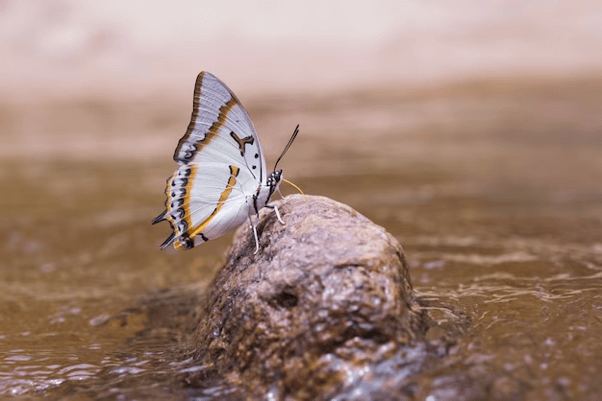Welcome to the mesmerizing world of Autoba moths, a captivating genus within the family Erebidae. Join us on a journey through the delicate wings and mysterious world of the Autoba genus, where diverse species showcase an array of patterns, colors, and behaviors.
In this blog, we will look into the fascinating details of the Autoba genus and spotlight one of its enchanting species, Autoba costimacula.
Introduction to Autoba Genus
In the vast world of insects, the Autoba genus emerges as a beacon of allure and fascination. Revered by entomologists and nature enthusiasts, Autoba moths, belonging to the family Erebidae, have intrigued scientists since their discovery by Francis Walker in 1863.
Taxonomy and Characteristics of Autobà
Autobà: Size and Coloration
Autoba moths exhibit a diverse range of sizes, painting the night sky with their varied wingspans. Their coloration, a captivating fusion of earthy tones and vibrant hues. It serves both protective and reproductive purposes, adding to their enchanting allure.
Wing Patterns and Distinctive Features
Elaborate wing patterns adorned with intricate lines and shapes distinguish Autoba moths. These patterns not only captivate observers but also aid in species identification, with each species showcasing unique features contributing to their survival in diverse environments.
Autoba costimacula – A Closer Look
As we delve deeper into the Autoba genus, our focus turns to the singular enchantment of Autoba costimacula. This unique species unveils distinctive traits, habitat preferences, and geographical nuances that set it apart in the nocturnal symphony of the insect world.
Distinctive Traits of Autobà Unveiled
Autoba costimacula captivates observers with its intricate wing patterns and subtle hues. Also, creating a mesmerizing picture against the canvas of the night. Its distinctive charm sparks the imagination, making it a unique and enchanting presence.
Habitat Preferences
The preferred habitats of Autoba costimacula span diverse landscapes, from dense woodlands to open meadows and water body fringes. Exploring these habitats reveals the delicate balance that supports the existence of Autoba costimacula within various ecosystems.
Geographical Distribution
Autoba costimacula graces temperate and subtropical regions worldwide, contributing its unique brushstroke to the global canvas of biodiversity. Exploring continents and regions provides insights into the expansive range and adaptability of Autoba costimacula.
Adaptations for Survival
Survival for Autoba costimacula involves a spectrum of adaptations, from camouflage strategies to behavioral nuances. Uncovering the secrets behind these adaptations offers a glimpse into the resilience that allows Autoba costimacula to thrive and contribute to the delicate balance of its ecosystem.
Nocturnal Ballet
Autoba costimacula engages in a nocturnal ballet orchestrated by the rhythms of the night. From graceful flights in search of nectar to intricate courtship dances under the moonlight, this species contributes to the continuity of its species. Witnessing this unique role within the dance of nature reveals the intricacies of Autoba costimacula’s contribution to the cycles of the night.
Life Cycle and Behavior of Autobà

The life cycle and behavior of Autoba moths unfold like a nocturnal symphony, weaving a captivating narrative that spans metamorphosis, feeding habits, mating rituals, and broader ecological roles.
Metamorphosis Unveiled
The life cycle of Autoba moths begins with the miraculous transformation from egg to larva, pupa, and finally, the emergence of the adult. Witness the intricacies of this metamorphosis, a testament to nature’s artistry and the resilience of these nocturnal wonders.
Feeding Habits of Autobà
As night descends, Autoba moths take to the air in search of nourishment, contributing to the ecological tapestry as vital pollinators. Explore their feeding habits, from sipping nectar to the role they play in the reproduction of plant species.
Mating Rituals
Under the moonlit skies, Autoba moths engage in intricate mating rituals, adding a touch of romance to the night. Delve into the behaviors that define courtship dances, pheromone communication, and the complexities of mate selection.
Autobà’s Nocturnal Behavior Patterns
Embrace the nocturnal ballet of Autoba moths as they navigate the darkness with grace. Explore their behavior patterns, including flight patterns, responses to environmental cues, and celestial navigation. These behaviors are finely tuned to the rhythms of the night, allowing Autoba moths to thrive in their unique ecological niches.
Ecological Roles
Beyond their individual behaviors, Autoba moths play crucial roles in maintaining ecological balance. Their feeding habits contribute to nutrient cycling, while pollination ensures the reproduction of plant species.
Survival Strategies
Uncover the survival strategies employed by Autoba moths in the face of challenges, showcasing their adaptability and resilience to navigate the complexities of their environments.
Autobà: Conservation Considerations
As we marvel at the life cycle and behaviors of Autoba moths, it becomes imperative to consider their conservation. Touch upon the potential threats they face, emphasizing the importance of preserving their habitats to ensure the continuation of their enchanting life cycle and behaviors.
In the dark embrace of the night, Autoba moths unfurl a tapestry of life that is as intricate as it is essential. From the delicate transformation of their life cycle to the nuanced ballet of their nocturnal behaviors. These moths beckon us to appreciate the wonders that unfold when the sun sets and the symphony of the night begins.
Autobà: Observation and Photography
Embarking on the observation and photography of Autoba moths offers enthusiasts a thrilling journey into the mysterious world of nocturnal wonders.
Observing and photographing Autoba moths is not just a visual delight; it’s a celebration of the intricate beauty that unfolds in the quietude of the night. As you immerse yourself in the nocturnal world, remember to tread lightly, respecting the delicate dance of these enchanting creatures.
Fun Facts and Trivia
Explore the charismatic side of Autoba moths with these fun facts and trivia, shedding light on the diverse and captivating aspects that have made them subjects of fascination and admiration in the world of nocturnal wonders.
Moth Navigators by Moonlight
Autoba moths showcase remarkable navigation skills, often relying on moonlight and celestial cues to traverse the night skies. Their ability to use lunar patterns for guidance sets them apart as expert nocturnal navigators.
Camouflage Masters
Many Autoba moth species exhibit exceptional camouflage, blending seamlessly with their surroundings. From intricate wing patterns mimicking bark to earthy tones that match foliage, their camouflage helps them evade predators during the day.
Feathery Antennae Elegance
Autoba moths are characterized by their feathery antennae. A distinctive feature that aids in detecting pheromones released by potential mates. The elegant, feather-like structure enhances their sensitivity to scents, contributing to successful courtship rituals.
Whispering Wings of Silence
The flight of Autoba moths is often described as a whispering breeze in the night. Their silent flight is achieved through specialized scales on their wings that minimize sound production. This stealthy approach helps them avoid predators while on the wing.
Moths of Many Colors
Autoba moths exhibit a dazzling array of colors, ranging from earthy browns and muted greens to vibrant oranges and pinks. The diverse color palette serves both as a form of camouflage and as an attraction mechanism during mating rituals.
Nocturnal Pollinators
As important contributors to nocturnal pollination, Autoba moths play a vital role in the reproductive success of various plant species. Moreover, their nectar-feeding behaviors facilitate the transfer of pollen, supporting the health and diversity of ecosystems.
Larval Feasting
Autoba moth larvae, known as caterpillars, have voracious appetites. They feed on a variety of plant materials, contributing to the recycling of nutrients in their ecosystems. The diverse diet of Autoba caterpillars showcases their adaptability to different plant species.
Dance of Courtship
Courtship dances among Autoba moths are a spectacle of elegance and precision. Male moths engage in intricate aerial maneuvers to attract females. These dances involve specific wing patterns and pheromone releases, creating a dance of courtship under the moonlit sky.
Global Nighttime Residents
Autoba moths have a global presence, inhabiting various continents and regions. Their adaptability to different climates and environments has allowed them to establish a widespread distribution, contributing to the rich biodiversity of the night.
Cultural Significance of Autobà
In various cultures, Autoba moths hold symbolic significance. They are sometimes associated with transformation, mystery, and even considered symbols of guidance in the darkness. Folklore and mythology often intertwine with the nocturnal presence of these enigmatic insects.
As you navigate the fascinating world of Autoba moths, may the beauty of their nocturnal existence and the intricate details of their lives inspire a deeper appreciation for the wonders that unfold when the sun sets, and under the sky the symphony of the night begins.







